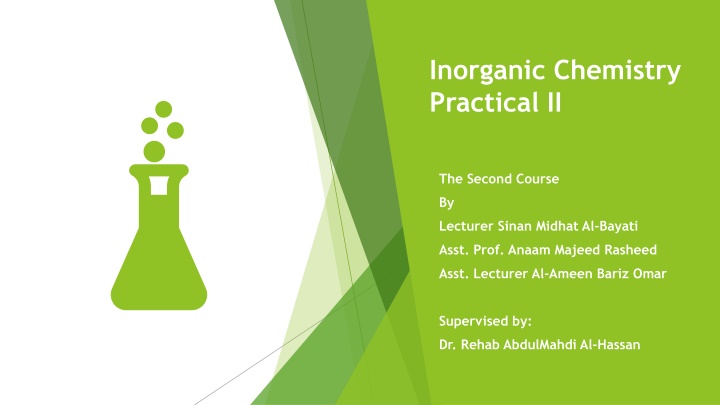
Inorganic Chemistry Practical II: Elements, Bonding, and Water Purification
Explore the characteristics of Group IV.A elements, the bonding nature of carbon, and the process of water purification in this Inorganic Chemistry Practical II guide. Understand why carbon forms single bonds, the reactivity of silicon and carbon with water, and the properties of charcoal. Dive into experiments involving water purification techniques and chemical reactions.
Download Presentation

Please find below an Image/Link to download the presentation.
The content on the website is provided AS IS for your information and personal use only. It may not be sold, licensed, or shared on other websites without obtaining consent from the author. If you encounter any issues during the download, it is possible that the publisher has removed the file from their server.
You are allowed to download the files provided on this website for personal or commercial use, subject to the condition that they are used lawfully. All files are the property of their respective owners.
The content on the website is provided AS IS for your information and personal use only. It may not be sold, licensed, or shared on other websites without obtaining consent from the author.
E N D
Presentation Transcript
Inorganic Chemistry Practical II The Second Course By Lecturer Sinan Midhat Al-Bayati Asst. Prof. Anaam Majeed Rasheed Asst. Lecturer Al-Ameen Bariz Omar Supervised by: Dr. Rehab AbdulMahdi Al-Hassan
The Fourth Group (IV A) The Elements Symbol Electronic Structure Carbon 6C 2[He] 2s22p2 Silicon 14Si 10[Ne] 3s23p2 Germanium 32Ge 18[Ar] 3d104s24p2 Tin 50Sn 36[Kr] 4d105s25p2 Lead 82Pb 54[Xe] 4f145d106s26p2
Questions: Why does carbon usually form four single bonds not double? Why do the electropositive of the metals increase from C Pb? Explain why a unique feature of Carbon is its propensity for bonding to itself in chains or rings not only C-C but C=C and C C. Why is CCl4 unreactive to H2O, whereas, SiCl4is rapidly hydrolyzed? CCl4 + H2O SiCl4 + 2H2O Si(OH)2Cl2 + 2HCl Si(OH)2Cl2 + 2H2O Carbon usually reacts with hydrogen but this reaction decreases for Si Pb, why? Why does silicon havemuch bonds to itself than carbon has? 1) 2) 3) 4) N.R. Si(OH)4 + 2HCl 5) 6)
Experiment No. (1) The Process of Purifying Water from Pollutants:
The Required Reagents: 1.Ammonium Hydroxid (5ml). 2.Sand (1gr). 3.Color Solution (5ml). 4.Charcoal (4gr). Procedure: 1. Put (1gr) of sand in the beaker then add (5ml) of NH4OH and (5ml) of color solution. 2. Add (25ml) of water to the beaker. 3. Add (4gr) of charcoal to same beaker with stirring. Filter the solution, observe the color of solution, and record the volume of solution. 1.
Questions: Give the properties of char coal. Give the reason why we use: Sand. NH4OH Color solution Write the equation of this experiment. Explain the physical effect and chemical reaction of this experiment. Why char coal is used in water purification?






















